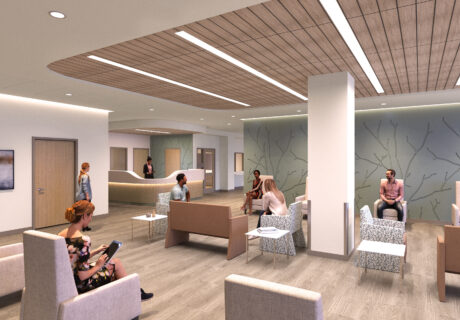Healthcare Leaders Identify Top Design Trends, Issues On Their Minds In 2023
Healthcare Design’s Take 5 column regularly invites leading healthcare design professionals, firms, and owners to tell us what has their attention and share their ideas on the subject.
This year, a range of topics were top of mind, including flexible and adaptable building designs, net zero strategies, AI in healthcare, supply chain disruptions, and specialty facility designs.
Read on for more on what was on the industry’s radar in 2023.
Responding to supply chain disruptions

Kevin Hinrichs, Taylor Design (Headshot credit: Taylor Design)
We’ve had materials fail to arrive when expected, leaving the subcontractors we scheduled unable to complete their work. Then, when the materials finally did come in, subcontractors were unavailable.
Because of the ripple effect that a supply chain disruption can cause to the design schedule, project teams must pay more attention upfront to what is likely and not likely to be available for procurement. This means doing parallel designs, as well as using varied materials and construction processes to build flexibility into the process.
Decisions on what to specify and how to construct the project need to happen much further in advance to allow time for designers to properly coordinate with other disciplines.—Kevin Hinrichs, president, Taylor Design (San Francisco). Read more from Hinrichs here.
Design with AI in mind

Mario Sanchez, Arcadis (Headshot credit: CRTKL)
Our team is seeing fast adoption of advanced technologies to help doctors analyze patients in new ways. For example, X-ray analytic software can identify a problem before the radiologist even looks at a screening. While the human eye is still important, diagnostic analysis will be enhanced and possibly even replaced by computational analyses and modeling.
New approaches to facility design may include where patients and doctors interact virtually during the diagnostic phase and rely on in-person interactions during the treatment stages. Treatment areas in facilities may need to increase capacity or extend hours of operations to avoid potential case logjams.— Mario Sanchez, associate principal and global technology solutions leader, Aracadis (Los Angeles). Read more from Sanchez here.
Making LGBTQ+ patients feel welcome

Maggie Mitchell, Dyer Brown & Associates (Headshot: Dyer Brown & Associates)
Many of the most interesting advances in healthcare design are happening in the behavioral health fields. Teen and adolescent LGBTQ patients, for example, often suffer from health disparities mainly because of fears of coming out and discrimination.
These patients may experience barriers to adequate mental health treatment. Designers can help create settings that build trust and help young clients overcome their fears of seeking care.
Incorporating all-gender restrooms, for example, lets these patients know they are expected, welcome, and understood.—Maggie Mitchell, associate and senior interior designer, Dyer Brown & Associates (Atlanta and Boston). Read more from Mitchell here.
Integrating healthcare, wellness into communities

Tatiana Guimaraes, Gensler (Headshot credit: Gensler)
Healthcare is more than accessibility and needs to be imbedded into people’s daily lives, integrated into communities, and focused on well-being. To achieve these goals, designing for experience—physically and virtually—is a must.
The best health environments are designed to be inviting, varied, and multiuse, bringing healthcare professionals and patients together to improve healthcare delivery while reducing costs.
Also, membership programs, concierge medicine, and virtual care are playing new roles and innovating healthcare delivery models used. —Tatiana Guimaraes, healthcare practice leader, Gensler (Miami). Read more from Guimaraes here.
Investments in healthcare infrastructure

Jacek Grabowski, RMF Engineering (Headshot: RMF Engineering)
The trend of repurposing empty buildings into healthcare spaces is driving investment in infrastructure. The most common infrastructure improvements include new air handling systems that can provide the quantity and quality of air required for healthcare occupancies.
In addition, depending on the services offered, an emergency back-up generator may be required to maintain power to medical refrigerators, critical computers, and treatment areas. Owners should identify new locations and then work with architects on test fits and feasibility studies to make sure the investment is worth it.—Jacek Grabowski is, project manager, RMF Engineering (Baltimore). Read more from Grabowski here.
Want to share your Top 5? Contact Managing Editor Tracey Walker at tracey.walker@emeraldx.com for submission instructions.


